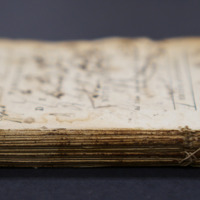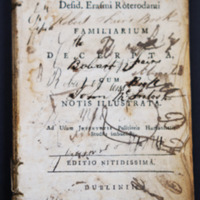Colloquiorum: Desid. Erasmi Roterodami familiarium decerpta, cum notis illustrata. […]
Dublin Core
Title
Colloquiorum: Desid. Erasmi Roterodami familiarium decerpta, cum notis illustrata. […]
Description
Two hundred and twenty years younger than its display case neighbour Les Ordonnances et édicts du très chrestien roy de France Charles neufiesme du nom […], this item is a good example of the economic measures taken to reduce the costs of bookbinding. This item is sewn on only two supports, as opposed to the three double sewing supports seen on the spine of the previous example. The supports appear to have been lost over time, as well as the entire outer binding, although their loss allows for yet another stellar demonstration of the book sewing process. This particular sewing style shows the “sawn-in” sewing technique. As to be seen in Les Ordonnances, sewing supports were raised from the spine and had to be accommodated in the outer leather binding of the spine. Changes in aesthetic tastes had an influence in bookbinding techniques. To ensure that a spine would not display raised bands, cuts would first be made into the spine with a saw. The supporting sewing cords would then be aligned with, and inserted into, the cuts, allowing the sewing supports to be hidden and providing for a flat spine.
Creator
Erasmus, Desiderius (1467-1536)
Source
Archives and Special Collections, University of Ottawa [PA8506 1794]
Date
1794
Rights
Archives and Special Collections, University of Ottawa
Format
Book
Language
Latin
Type
Text
Identifier
ARSC_RB_PA8506 1794
Collection
Citation
Erasmus, Desiderius (1467-1536), “Colloquiorum: Desid. Erasmi Roterodami familiarium decerpta, cum notis illustrata. […],” Archives and Special Collections, University of Ottawa Library, accessed December 14, 2025, http://omeka.uottawa.ca/arcs-en/items/show/4.


